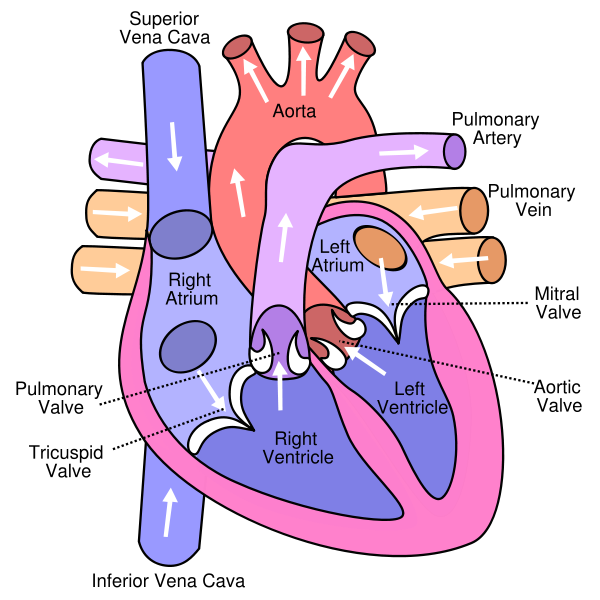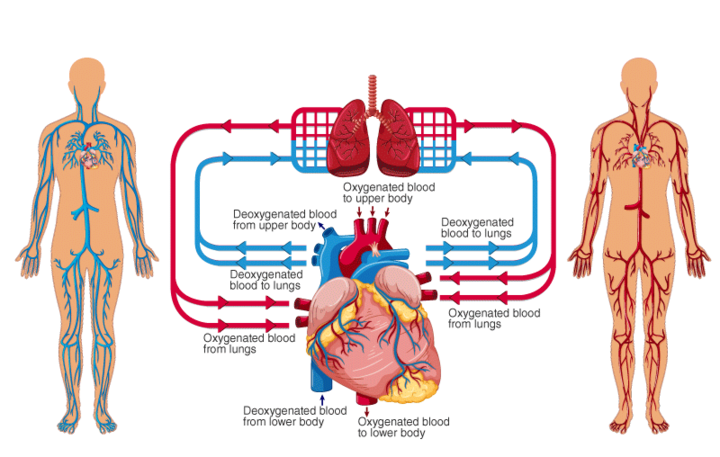जीवविज्ञान नोट्स: हृदय और मानव परिसंचरण प्रणाली
खुले परिसंचरण तंत्र के विपरीत जिसमें रक्त खुले अवकाशों में बहता है, मानवों में बंद परिसंचरण तंत्र पाया जाता है जहाँ रक्त का प्रवाह रक्त नलिकाओं के बंद जाल में होता है।
रक्त परिसंचरण की खोज वैज्ञानिक विलियम हार्वे द्वारा की गयी थी।
इसके चार भाग हैं
(i) ह्रदय
(ii) धमनियाँ
(iii) शिरायें
(iv) रुधिर
ह्रदय:
- हृदय एक पंपिंग अंग है जो कि एक लयबद्ध तरीक से संकुचन (आयतन कम होने) और फैलाव (आयतन बढ़ने) की चक्रीय प्रक्रिया में कार्य करता है।
- इन दोनों के एक चक्र पूरा होने पर एक हृदय की धड़कन कहते है और मनुष्य के ह्रदय में यह चक्र पूरा होने में 0.8 सेकण्ड लगते हैं।
- यह हृदयावरण में सुरक्षित रहता है।
- इसका भार लगभग 300 ग्राम है।
- मनुष्य का हृदय चार कोष्ठों का बना होता है।
- अगले भाग में दायां आलिंद और बायां आलिंद होता है।
- पिछले भाग में दायां निलय और बायां निलय होता है।
- दायें आलिंद और दायें निलय के मध्य त्रिवलनी कपाट होती है।
- बायें आलिंद और बायें निलय के मध्य द्विलनी कपाट होती है।
- शिरायें वे रक्त वाहिनियाँ हैं जो रक्त को शरीर से हृदय की ओर ले जाती हैं।
- शिराओं में कार्बनडाइऑक्साइड युक्त अशुद्ध रक्त होता है।
- पल्मोनरी शिरा एक अपवाद है यह शुद्ध रक्त का प्रवाह करती है।
- पल्मोनरी शिरा फेफड़े से बायें आलिंद में रक्त का प्रवाह करती है। इसमें शुद्ध रक्त पाया जाता है।
- धमनियाँ वे वाहिनियाँ हैं जो सदैव हृदय से शरीर की ओर रक्त का प्रवाह करती हैं।
- धमनियों में शुद्ध ऑक्सीजन युक्त रक्त का प्रवाह होता है।
- लेकिन पल्मोनरी धमनी इसका अपवाद है यह सदैव अशुद्ध रक्त का प्रवाह करती है।
- पल्मोनरी धमनी में रक्त का प्रवाह दायें निलय से फेफड़े की ओर होता है। इसमे अशुद्ध रक्त होता है।
- हृदय के दाहिने भाग में, अशुद्ध (कार्बनडाइऑक्साइड युक्त) रक्त रहता है, जबकि हृदय के बाएं भाग में शुद्ध ऑक्सीजन युक्त रक्त रहता है।
- हृदय की मांसपेशियों को रक्त पहुँचाने वाली धमनियों को कोरोनरी धमनी कहते हैं। इसमें किसी भी प्रकार के अवरोध आने पर हृदयाघात होता है।
 परिसंचरण का मार्ग:
परिसंचरण का मार्ग:
- स्तनधारियों में द्विपरिसंचरण होता है।
- इसका अर्थ है कि रक्त को पूरे शरीर में प्रवाहित होने से पूर्व हृदय से दो बार गुजरना होता है।
- दायां आलिंद शरीर से अशुद्ध रक्त प्राप्त करता है जहाँ से यह दायें निलय में प्रवेश करता है। यहाँ से रक्त पल्मोनरी धमनी में जाता है जो इसे फेफड़े में शुद्धिकरण के लिये पहुँचाती है। शुद्धिकरण के बाद रक्त पलमोनरी शिरा द्वारा एकत्रित कर वापस हृदय में बायें आलिंद में पहुँचता है। यहाँ से रक्त बायें निलय में पहुँचता है। इस प्रकार का यह एक पूर्ण परिसंचरण हृदय चक्र कहलाता है।

हृदय चक्र:
- हृदय चक्र को हृदय में दो पेसमेकरों द्वारा नियंत्रित किया जाता है।
- साइनो-आर्टियल-नोड (एसए नोड) दायें आलिंद की ऊपरी दीवार पर स्थित होता है।
- एट्रियो-वेंट्रिकुलर नोड (एवी नोड) दायें आलिंद एवं दायें निलय के मध्य स्थित होता है।
- दोनो ही पेसमेकर तंत्रिका तंत्र प्रकार के होते हैं।
रक्त दाब:
- वह दाब जो रक्त द्वारा रक्त वाहिनी नलिका पर लगाया जाता है, रक्त दाब कहलाता है।
- शरीर के अंगों तक रक्त पहुँचाने वाली रक्त वाहिनियों में यह अधिक होता है (सिस्टोलिक दाब)
- शरीर से हृदय तक रक्त पहुँचाने वाली रक्त वाहिनियों में कम होता है। (डायसिस्टोलिक दाब)
- सामान्य रक्त दाब 120/80 mm Hg होता है।
 बेतार कृत्रिम पेस मेकर:
जब एस.ए. नोड खराब या छतिग्रस्त हो जाता है तो हृदय की धड़कनें उत्पन्न नहीं होती हैं।
इसके समाधान लिये हम बेतार पेसमेकर का प्रयोग करते हैं जो कि अंग के बाहर बेतार पराध्वनिक तरंग से हृदय की धड़कन को नियंत्रित करती है।
यह पारंपरिक पेसमेकर से बेहतर है क्योंकि तार के खराब हो जाने की स्थिति में उसे बदलने के लिये अतिरिक्त सर्जरी की आवश्यकता नहीं पड़ती है।
बेतार कृत्रिम पेस मेकर:
जब एस.ए. नोड खराब या छतिग्रस्त हो जाता है तो हृदय की धड़कनें उत्पन्न नहीं होती हैं।
इसके समाधान लिये हम बेतार पेसमेकर का प्रयोग करते हैं जो कि अंग के बाहर बेतार पराध्वनिक तरंग से हृदय की धड़कन को नियंत्रित करती है।
यह पारंपरिक पेसमेकर से बेहतर है क्योंकि तार के खराब हो जाने की स्थिति में उसे बदलने के लिये अतिरिक्त सर्जरी की आवश्यकता नहीं पड़ती है।

हृदय से जुड़ी बीमारियाँ:
धमनी का पत्थर होना: इसमें धमनियों में सजे टुकड़ों के निर्माण और कैल्सीकरण के कारण धमनी की दीवारें कठोर हो जाती हैं।
एथ्रोस्केलेरोसिस: धमनियों की दीवारों में कोलेस्ट्रॉल के जमा होने के कारण वे पतली हो जाती हैं और जिसके कारण उनमें रक्त के प्रवाह में रूकावट आती है।
हृदय घात: हृदय में अचानक रक्त की आपूर्ति में कमी आने पर हृदय घात होता है जिसके कारण हृदय की मांसपेशी क्षतिग्रस्त हो जाती हैं।
Biology Notes: Heart & Human Circulatory System
Circulatory systems are of two types Open Circulatory system and Close Circulatory System. Human being posses Close circulatory system where blood flows through a closed nexus of blood vessels in contrary to open circulatory system where blood flows in open spaces.
It contains four parts:
(i) Heart
(ii) Arteries
(iii) Veins
(iv) Blood.
The discovery of blood circulation system was done by William Harvey.
Points to remember:
Biological term of the heart is ‘Cardio’.
It remains safe in the pericardial membrane.
Its weight is approximately 300 grams for male and 250 gms for female.
The human heart is a four chamber heart.
In one cycle heart pumps 70ml blood.
The major function of the heart is Pumping of blood/circulation of blood.
The heartbeat of a normal human being is 72 beats/minute.
The heartbeat of the shrew is maximum in shrew ie 800 beats per minute.
It contains the right atrium and a left atrium in the anterior part.
there is a tricuspid valve between the right atrium and the right ventricle.
there is a bicuspid valve between the left atrium and left ventricle.
It contains right ventricle and a left ventricle persists in the posterior side.
It is a pumping organ works in a rhythmic cyclic manner with systole(shrinkage for .3sec) and diastole (expansion for .5 sec).

A heartbeat lasts for 0.8 seconds and consists of both of these.
The vein is the vessels which carry the blood from the body towards the heart.
The vein contains impure blood i.e. carbon dioxide mixed blood.
Pulmonary vein is the exception which always carries pureblood.
Pulmonary vein carries the blood from the lungs to the left atrium.
The artery is the vessel which carries the blood from the heart towards the body.
Artery contains pure blood i.e. oxygen mixed blood.
But Pulmonary arteries are the exception which always carries the impure blood or deoxygenated blood.
The pulmonary artery carries the blood from the right ventricle to the lungs.
In the right part of the heart, there remains impure blood i.e. carbon dioxide mixed blood and in the left part of the heart there remains pure blood i.e. oxygen mixed blood.
The artery carrying blood to the muscles of the heart is called coronary arteries. Any type of hindrance in it causes a heart attack.
Covering of heart is called as Pericardium.
The course of circulation:
Along with a closed circulatory system, Mammals have double circulation.which means blood has to cross two times from heart before circulating throughout the body.
The right atrium receives impure blood from the body which goes into the right ventricle. From here the blood went into pulmonary artery which sends it to the lung for purification. After purification, it is collected by a pulmonary vein which brings it back to the heart in the left atrium. From the atrium, it vents into the left ventricle. Now, this purified blood goes into the aorta for different organ of the body. This circulation is done is a cardiac cycle.

Cardiac cycle:
The cardiac cycle is controlled by two pacemakers in the heart:
The sino-atrial node (SA node) located in the top wall of the right atrium, also known as the heart of the heart.
The atrioventricular node (AV node) located in between the right atrium and ventricle.
Both pacemakers are types of nervous tissue.
Blood Pressure:
The force per unit area which is exerted on the walls of the blood carrying tube by blood called blood pressure.
Normal rating of blood pressure in a healthy person is 120/80 mm Hg.
Blood pressure is high in tubes which carry blood to the body parts (systolic pressure) and low in tubes which carry blood to the heart (diastolic pressure).
Wireless Artificial Pacemaker:
When the SA node becomes defective or damaged the cardiac impulses do not generate.
For this, we use wireless pacemaker that regulates the heart by wireless pulses of ultrasound from outside the organ.
It is beneficial over conventional pacemaker as the leads can fail and requiring the additional surgery to replace them.
Cardiovascular Diseases:
Arteriosclerosis:
It is thickening, hardening or loss of elasticity of the arteries due to the formation of plaques and calcification in their walls. It is caused by the buildup of fatty plaques, cholesterol, and some other substances in and on the artery walls.
Atherosclerosis:
Deposition of cholesterol in the walls of arteries due which they become narrow and hinder the blood flow to them.
Heart Attack: A heart attack occurs when one or more of your coronary arteries become blocked. Over time, a coronary artery can narrow from the buildup of various substances, including cholesterol (atherosclerosis).

0 Comments